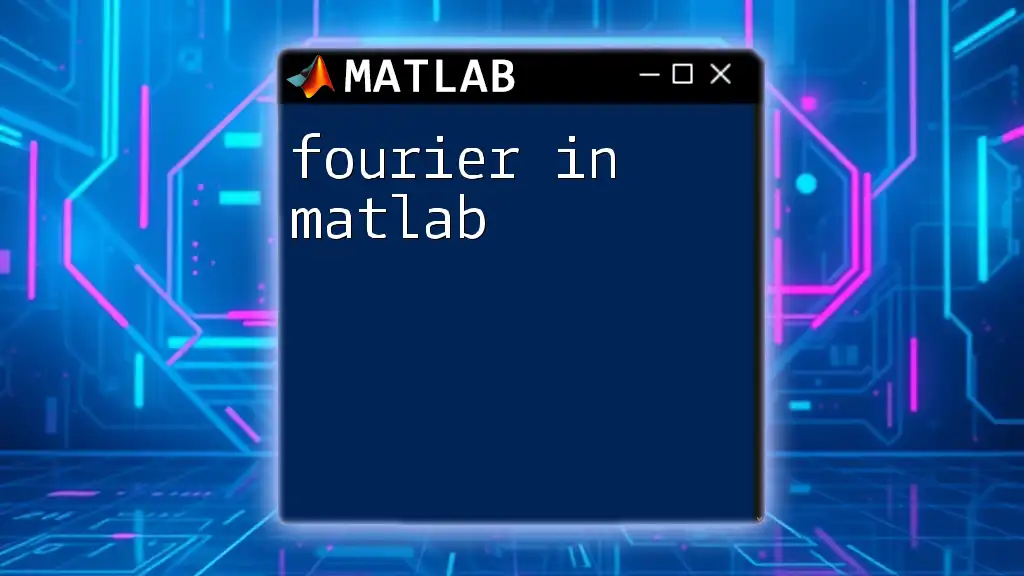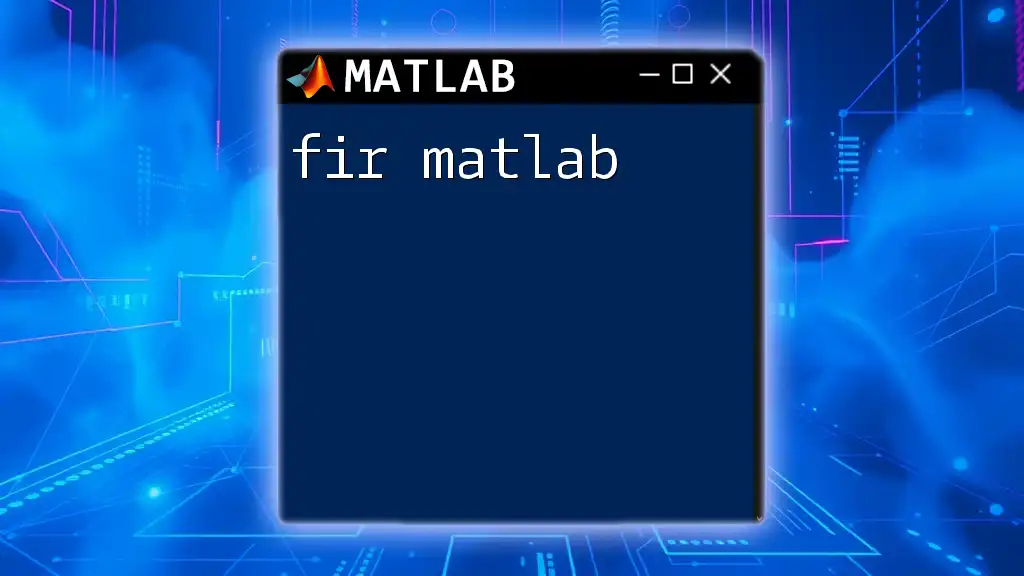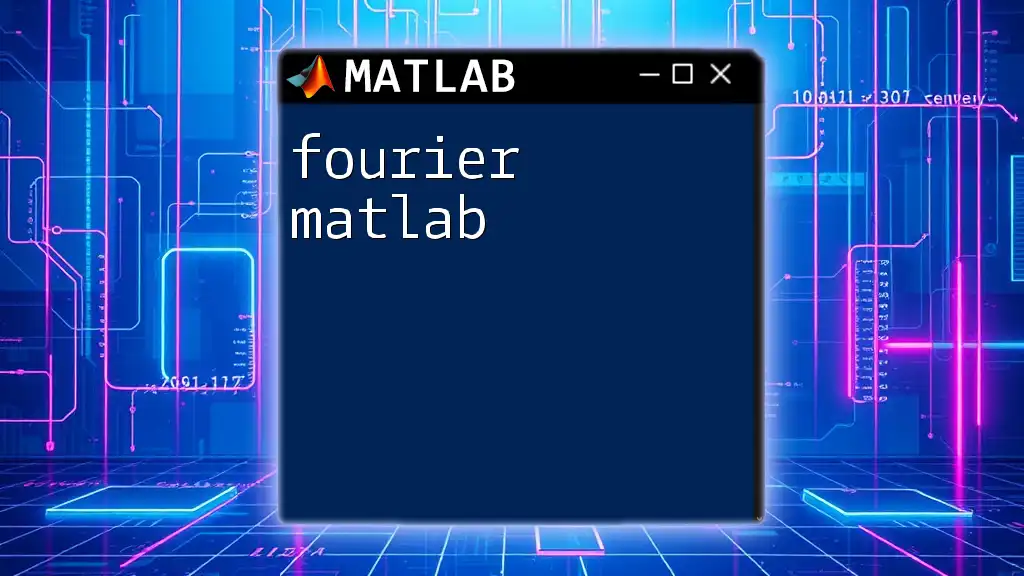The Fourier Transform in MATLAB is a powerful tool used for converting signals from the time domain to the frequency domain, allowing for analysis of frequency components in signals.
Here's a simple code snippet to compute the Fast Fourier Transform (FFT) of a signal:
% Define a sample signal
t = 0:0.01:1; % Time vector from 0 to 1 second, sampled at 100 Hz
f = 5; % Frequency of the signal
signal = sin(2*pi*f*t); % Create a sine wave
% Compute the Fast Fourier Transform
Y = fft(signal);
% Compute the frequency axis
Fs = 100; % Sampling frequency
f = (0:length(Y)-1) * Fs / length(Y);
% Plot the signal and its FFT
subplot(2,1,1);
plot(t, signal);
title('Time Domain Signal');
xlabel('Time (s)');
ylabel('Amplitude');
subplot(2,1,2);
plot(f, abs(Y));
title('Frequency Domain (FFT)');
xlabel('Frequency (Hz)');
ylabel('Magnitude');
Understanding Fourier Transform
What is Fourier Transform?
The Fourier Transform is a mathematical transformation that expresses a function in terms of the frequencies it comprises. It is a powerful tool for analyzing different types of signals, allowing the conversion of time-domain data into the frequency domain. This transformation is widely applied in fields such as signal processing, communications, audio analysis, and image processing.
Essentially, the Fourier Transform breaks down a signal into its constituent sine and cosine waves, facilitating frequency analysis and manipulation.
Types of Fourier Transforms
-
Continuous Fourier Transform (CFT): This is used for continuous signals and is defined by the integral of the function multiplied by complex exponentials. Its mathematical representation is given by:
\[ F(w) = \int_{-\infty}^{+\infty} f(t)e^{-j \omega t} dt \]
-
Discrete Fourier Transform (DFT): The DFT is specifically designed for discrete data, turning a sequence of equally spaced samples into its frequency components. It is defined by:
\[ X(k) = \sum_{n=0}^{N-1} x(n)e^{-j \frac{2\pi}{N}kn} \]
-
Fast Fourier Transform (FFT): An optimized algorithm for computing the DFT. FFT significantly reduces the computation time, making it suitable for real-time applications.

The Fourier Transform in MATLAB
Setting Up MATLAB
To start using Fourier MATLAB, ensure that you have MATLAB properly installed. If you have additional toolboxes (like the Signal Processing Toolbox), it's beneficial for advanced functionalities. Once installed, familiarize yourself with the MATLAB environment, including the editor, command window, and workspace.
Basic Commands for Fourier Analysis in MATLAB
One of the core functions for performing a Fourier Transform in MATLAB is `fft()`. This function computes the Fast Fourier Transform of a sequence.
The basic syntax of the `fft()` function is as follows:
Y = fft(X);
Example: Let's create a simple signal and perform an FFT.
t = 0:0.01:1; % Time vector
x = sin(2*pi*5*t) + sin(2*pi*10*t); % Simple signal
Y = fft(x); % Compute the FFT
Visualizing Fourier Transforms
Visualization plays a critical role in understanding the frequency domain representation of signals.
To plot the original signal, use the following code:
plot(t, x);
title('Original Signal');
xlabel('Time (s)');
ylabel('Amplitude');
To visualize the FFT result, we can plot the magnitude spectrum:
n = length(x); % Length of the signal
f = (0:n-1)*(100/n); % Frequency vector based on sampling frequency
plot(f, abs(Y)); % Magnitude spectrum
title('Magnitude Spectrum');
xlabel('Frequency (Hz)');
ylabel('|Y(f)|');

Advanced Techniques with Fourier Transforms
Inverse Fourier Transform
The Inverse Fourier Transform allows for retrieving the original time-domain signal from its frequency-domain representation. In MATLAB, this can be done using the `ifft()` function:
x_reconstructed = ifft(Y);
It's beneficial to compare the original signal with the reconstructed signal to verify accuracy.
Short-Time Fourier Transform (STFT)
The Short-Time Fourier Transform (STFT) analyzes signals whose frequency content changes over time. This technique allows you to capture transient phenomena effectively.
To implement STFT in MATLAB, use the `spectrogram()` function:
spectrogram(x, hanning(128), 120, 512, 1000);
The resulting spectrogram visually represents how the frequencies of a signal change over time, providing insight into the time-varying nature of the signal.

Practical Applications of Fourier in MATLAB
Audio Signal Processing
In audio processing, the Fourier Transform is essential for frequency analysis, filtering, and sound synthesis.
For instance, you can analyze an audio file using the following code:
[y, Fs] = audioread('audiofile.wav'); % Load audio file
Y = fft(y); % Perform FFT on audio signal
With this, you obtain the audio frequency spectrum, allowing you to manipulate various audio characteristics.
Image Processing
The Fourier Transform is also instrumental in image processing, particularly for filtering and enhancing images. Applying a Fourier Transform to an image can reveal frequency components important for applications like noise reduction.
To perform frequency filtering, use:
img = imread('imagefile.jpg'); % Load image
F = fft2(img); % Compute 2D FFT
% Manipulate frequency domain here (e.g., filter, enhance)
The ability to manipulate frequencies provides powerful techniques for improving image quality and analysis.

Conclusion
In this comprehensive exploration of Fourier MATLAB, we've covered the fundamentals of Fourier Transforms, their types, and how to implement them in MATLAB. By understanding and applying these concepts, users can analyze and manipulate signals effectively across various domains, including audio and image processing.
With the rich set of functions provided by MATLAB, you are now equipped to dive deeper into Fourier analysis and its practical applications. Practice with the examples provided and explore further to enhance your understanding of Fourier analysis in MATLAB.

















